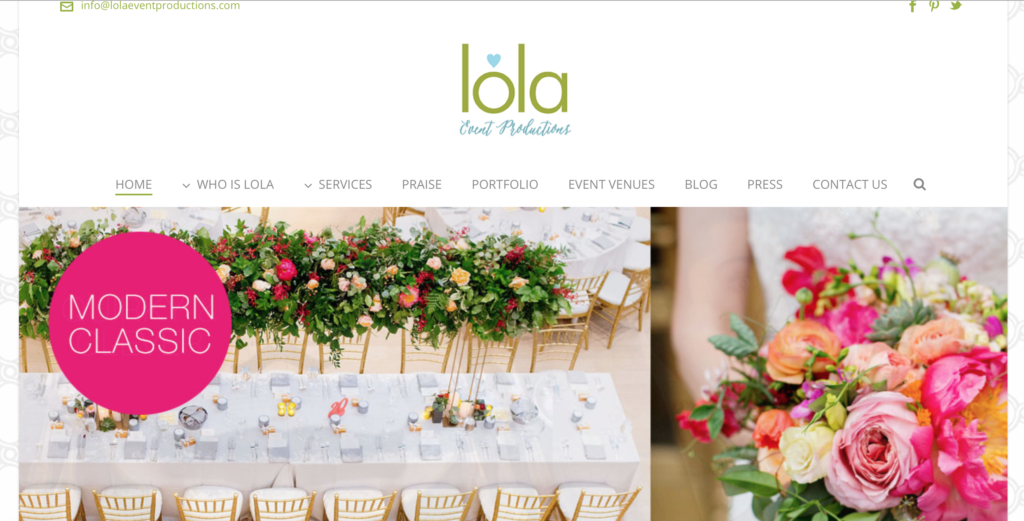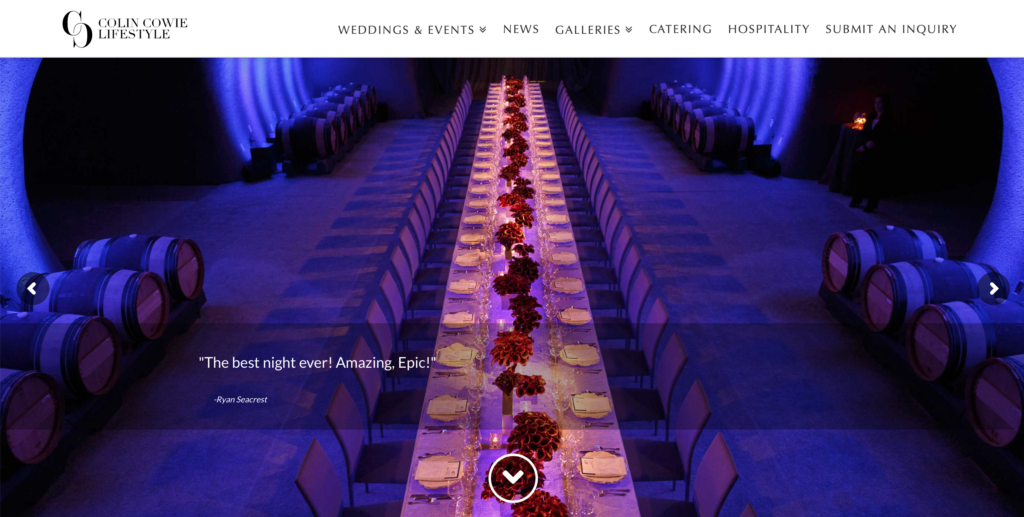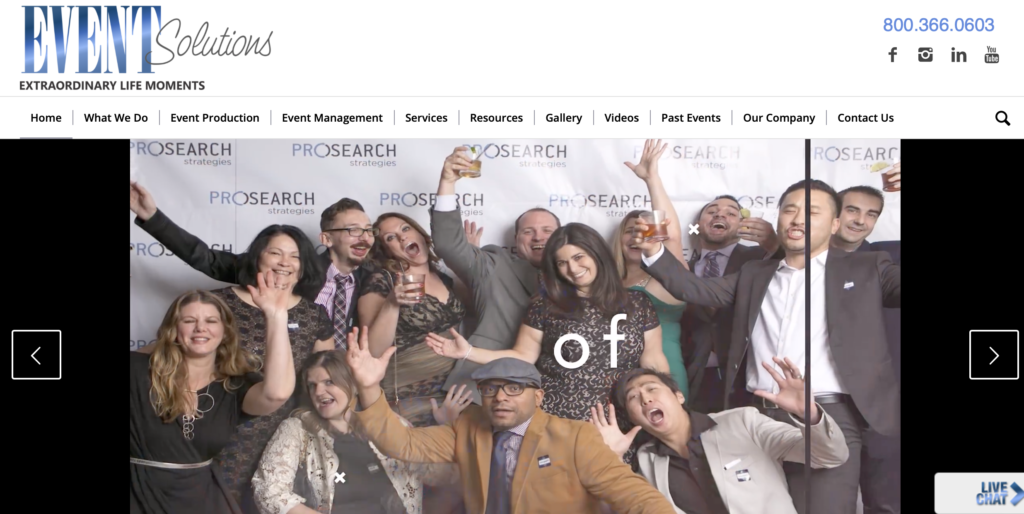
Monday Motivation: Event Planning Portfolio Basics
Experts agree that building an event planning portfolio is probably the most important thing you’ll do as an events professional in terms of marketing yourself to your target audience. A digital event portfolio basically shows the world who you are, what you do, and how talented you really are.
Creating one – especially if it’s an event planning portfolio for an interview at a new company – can feel a little overwhelming. But this guide will take you through the basics and answer your most burning questions.
Discover an Event Portfolio’s Definition & Purpose
An event portfolio is typically found online and represents the work of an individual or an event planning company. In it you’ll find things that prove how successful this person or group is at event planning. From event photos to testimonials, an event portfolio is all about showing off your event planning abilities in their best light.
A corporate events portfolio or a wedding and events planning portfolio both serve the same purpose: to demonstrate skill and build trust in the viewer. Overall it’s a powerful tool for acquiring new business.
What Does an Events Portfolio Look Like?
An events portfolio well designed, shows who you are, and clearly explains what you do. It builds trust in your target audience. It is well branded and features your past event planning experience, education, and awards. As long as your events portfolio includes these items, there is no strict rules in how you present them. But, like any good website, your portfolio should be easy to read and navigate.
We’ve gathered some event planning portfolio examples to inspire your own design efforts:

1. Lola Event Productions
Lola Event Productions is a team of event planners located in Chicago. They’re combined 50+ years worth of experience in weddings and private events has helped them build their strong event planning portfolio.
Why We Love It: In addition to an easy to understand navigation bar, the homepage of Lola Event Productions features eye-catching imagery, a banner featuring their latest awards, and some impressive media mentions in industry renowned outlets.

2. Colin Cowie Lifestyle
Colin Cowie Lifestyle is an event planning company that creates weddings and private parties for the rich and/or famous. So in terms of testimonials, they’ve got most people beat. But there are other facets of their digital event planning portfolio that make it really stand out.
Why We Love It: Because Colin Cowie Lifestyle specializes in luxury events, it’s important that their events portfolio reflects an upscale vibe. They pull this off well by including elements like a featured Instagram panel (hosting a collection of exceptionally beautiful event photos) and single line client quotes that promote the brand’s simplistic elegance.

3. Event Solutions
Company parties and corporate events are the bread and butter of Event Solutions. In addition to great website design, this event planning portfolio example makes it easy for potential clients to consider spending their large event budgets on their services.
Why We Love It: Event Solutions understands that seeing is believing. So in addition to sharing their event photos they also prominently feature event videos on their event planning portfolio site. And in case it wasn’t obvious from their impressive event examples, Event Solutions also spells out why you should with them using a bulleted list that highlights their unique selling points without any extra fluff.
Now that you know how to tell if someone else’s event planning portfolio is on point or not, it’s time to make one of your own! Here’s what you’ll need to build it along with ways to make it more unique.
Learn the Digital Event Portfolio Basics
Content is the most important component of any portfolio in the events industry or otherwise. Once you have those elements in place you can begin experimenting with ways to stand out from the competition. But at the bare minimum, your portfolio should include each of the following:
Top 10 Items to Include in an Event Portfolio
One of the best ways to break into event planning is to gain experience in whatever ways you can. But what good is experience if you don’t show the world you have it? In addition to showcasing your talent, you need to make sure your portfolio looks good, is highly functional, and includes some practical business elements as well. Just follow this list and you’ll be fine.
1. Logo, Brand Colors, and Tagline
Like all your other marketing materials, your event planning portfolio should align with your company’s usual look and feel. Most event planning portfolios will include a logo in the website header and weave in 2-3 primary brand colors throughout each page.
2. Client Testimonials
Ask people you’ve planned events for to share a few nice words. You can even get their permission to share the quote alongside their own name and event details. But don’t just limit yourself to clients – if your resume is a bit thin, consider asking past mentors, college professors, or anyone you’ve done volunteer work with to vouch for other important event planning skills (like work ethic, creativity, etc.).
3. Before & After Photos of Your Events
The day of the actual event is, as you already know, really hectic. But snapping these photos and sharing them on your portfolio is really important because it allows your resume to come alive. Show off your overall event designs in action but also make sure to take close ups of details like centerpieces. And, if the host allows it, snap some pics of the attendees enjoying themselves too.
4. Event Set Up Timelapse Videos
Event design is the most impressive and visual aspect of any event planning process. And, as we’ve already mentioned in our previous examples, using video on your portfolio site is great for engaging your site visitors.
5. Awards and Certifications
Most professional accolades will send or give access to their official digital emblem, badge, or logo to display on your own digital properties. Place these towards the top of your homepage and make sure they get more detailed descriptions or another prominent placement elsewhere on the site where you can explain why you won the award or just what it’s all about.
6. An About You or Meet the Team Section
This is the place to highlight some fun facts about your and your team. Use professional photos of yourself. And be sure to write bios that emphasize your strengths as an event planners (your parents were involved in the events industry or perhaps your visual arts hobby has translated into your career, that kind of thing).
7. Social Media Links
If you got them make sure they’re displayed on your portfolio site. Or, if you’re doing a hard copy portfolio, add your handles to the last page alongside your contact info. And do a sweep of all your accounts to make sure the posts and photos still align with your brand (and your new portfolio too).
8. Press or Media Mentions
Whether you have PR help or you’re just getting some rave reviews on Yelp, make sure you display these credibility indicators loud and proud. Link to the original articles where you can.
These last two deserve honorable mentions and while they’re certainly not required you’ll definitely earn a gold star for including them in your event planning portfolio anyways.
9. Timeline Drafts
It’s a good idea to give potential clients or employers a sneak peek at what they can expect to receive when they begin working with you. You can even draft one for a fictional event to use as a sample. By the way, here are some event planning timeline tips you can try out.
10. Event Inspiration Boards
Whether it’s Pinterest or a handmade bulletin board display, sharing your event inspiration boards is a great way to let viewers know how you think. They can also view any recurring themes in your work or how diverse your style might be project to project.
So you’ve gathered all your materials. Now how do you actually make the thing? We’re so glad you asked.
Explore Helpful Event Planning Portfolio Tools
There are lots of affordable tools out there, no matter how you plan to make or share your event planning portfolio. Here are a handful we recommend using:
- A Binder or Album. The debate over print portfolios vs. digital portfolios is still raging across all professions but it’s good to have at least one digital and one physical portfolio entity, even if only to have all your bases covered. Use a high quality binder or album to piece your materials together. Get crafty but keep it classy – too much glitter or construction paper cut outs might be off putting to clients.
- Website Builders & Templates. Sites like Wix and Squarespace make it easy to create your own event planning portfolio site without any coding experience. Wix specifically offers some great event planning and professional portfolio templates you can use for free.
- Social Tables. One of the best things you can show on your event planning portfolio is actual statistical proof that verifies you set an event goal and reached it. Using event management software can help you track your progress, calculate ROI, and provide that extra special something to round out your already amazing portfolio.
Using all the information we covered so far, you’ve got yourself a pretty great foundation for your event planning portfolio. But we know you want to take it a step further and create something really one of a kind, so here are some suggestions for how to do just that.
How to Make Your Wedding and Event Planning Portfolio Stand Out
One of the best ways to make your event planning portfolio stand out is to customize it for every new client. Cherry pick the materials that most closely match the client’s brand, event goals, and personal tastes. This is tough to do with your online portfolio but the good news is that it’s really easy to change up your physical portfolio without actually having to give it a complete makeover.
If you’d like the mix things up with the content itself, look up other local event planners and take a peek at their digital portfolios. If you notice a pattern (like the exact same fonts or similar layouts) try to deviate from it in a way that is still visually appealing and functional. When clients search for you and your competition online, what portfolio elements will they find on your page and not theirs? These differences will help make yours more memorable.
Event Portfolio Planning and Management
At the end of the day, it’s totally possible to book a client without a portfolio. But if have any experience or event planning education at all, you’ll be giving yourself more opportunities if you do. If you’d like more tips on the business side of event planning, study these guides while you’re here:

